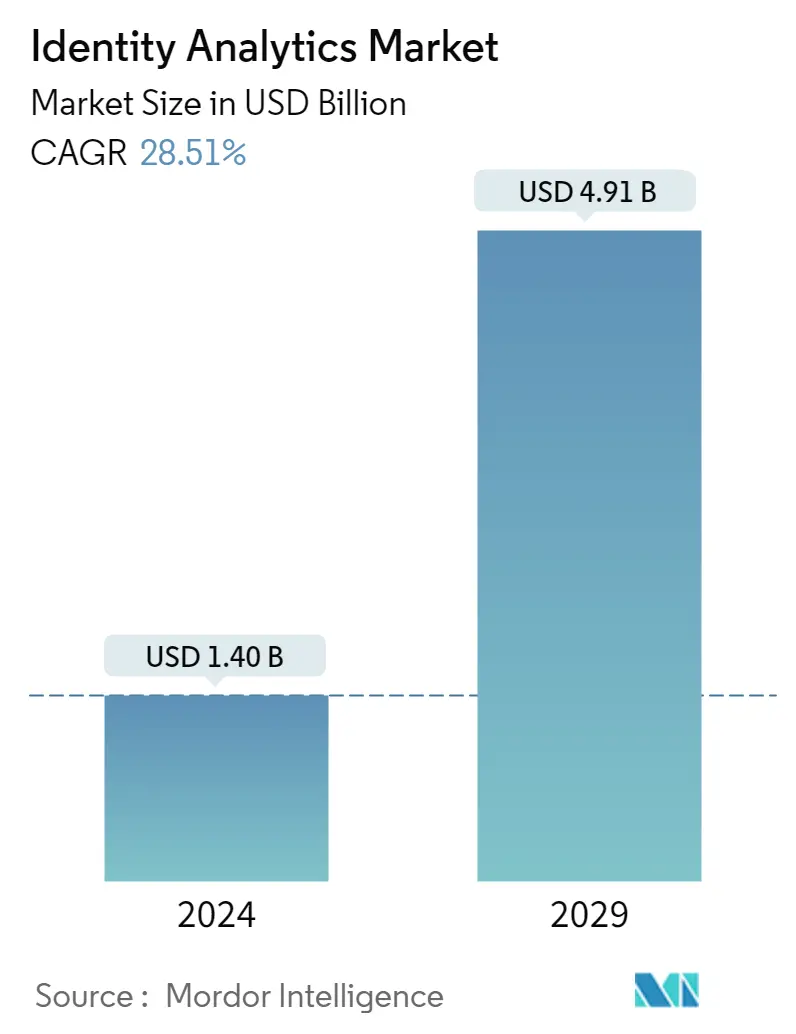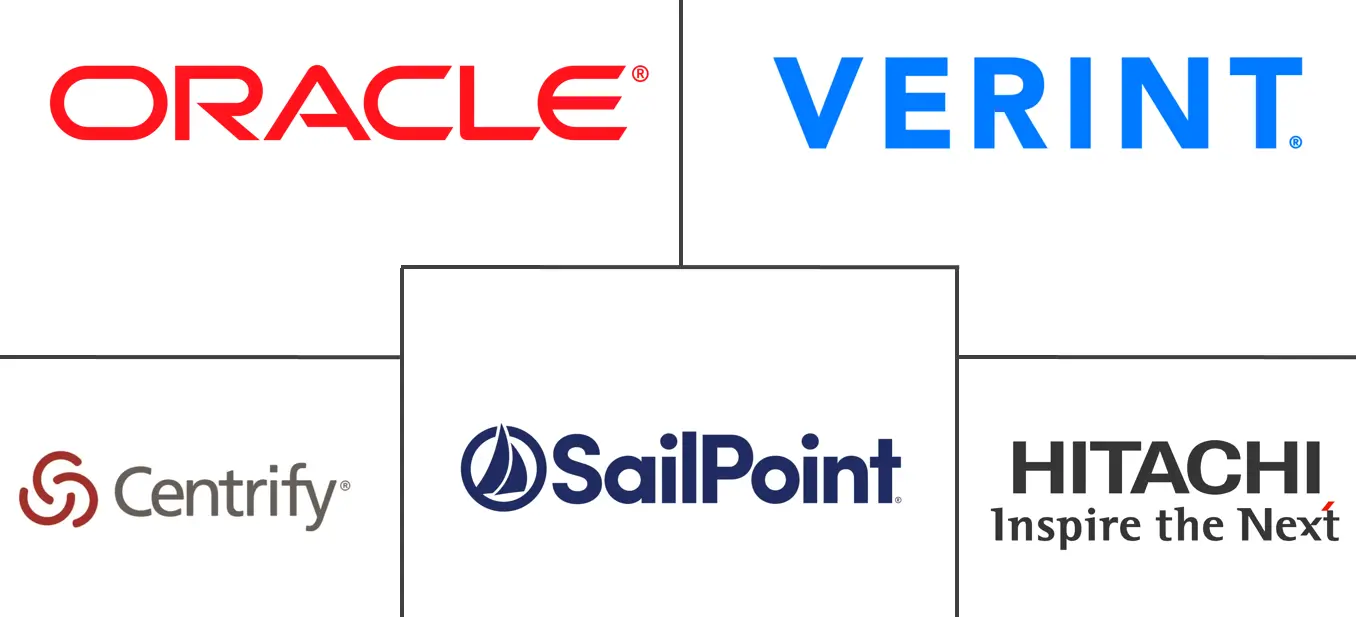Market Size of Identity Analytics Industry

| Study Period | 2019 - 2029 |
| Market Size (2024) | USD 1.40 Billion |
| Market Size (2029) | USD 4.91 Billion |
| CAGR (2024 - 2029) | 28.51 % |
| Fastest Growing Market | Asia Pacific |
| Largest Market | North America |
Major Players
*Disclaimer: Major Players sorted in no particular order |
Identity Analytics Market Analysis
The Identity Analytics Market size is estimated at USD 1.40 billion in 2024, and is expected to reach USD 4.91 billion by 2029, growing at a CAGR of 28.51% during the forecast period (2024-2029).
- Identity analytics solutions are key in making informed decisions about user access and permissions. These solutions use advanced analytics and machine learning to mitigate the risk of identity access. Organizations are adopting new technologies, such as advanced analytics and machine learning solutions, to ensure continuous compliance.
- Enterprises worldwide are increasing spending on digitization, including the payment processes, and the push towards digitization can be witnessed in all types of organizations. According to a recent TechRepublic Premium survey, 47% of the respondents planned on spending more on digital transformation in 2021 than in 2020. In addition, in 2020, 58% of the respondents reported digitizing paper, and 45% reported adopting online training modules.
- The market for identity analytics is primarily driven by elements like the adoption of solutions through strict regulations, the requirement for compliance, and the adoption of BYOD trends in businesses. The INFORM (Integrity, Notification, and Fairness in Online Retail Marketplaces) Consumers act, for instance, was introduced in March 2021. Retailers are required by the law to confirm the legitimacy of the top market sellers. Identity verification solutions are deployed in various end-user industries as a result of the government's strict regulations.
- As enterprise IT adopts more cloud systems while maintaining on-premises solutions, controlling who can access which applications become more important. This poses a new challenge for enterprises and their teams regarding identity analytics. Some of the challenges include identity management, compliance visibility, and more.
- During the COVID-19 pandemic, identity analytics solutions will positively impact the market and contribute to its growth significantly during the forecast period. Vendors operating in the market have also witnessed a surge in revenue owing to the pandemic. In February 2021, Ekata announced that its revenue surged with the addition of 300 new customers. The pandemic accelerated the adoption of e-commerce, boosting demand for services, such as identity verification, to safeguard against cyber fraud.
Identity Analytics Industry Segmentation
Identity analytics solutions allow businesses to define and manage roles and automate vital identity-based controls. Once the roles are certified and assigned, the software solutions continue to deliver scalable identity governance. The market scope of identity analytics tracks the adoption of different solutions and services used by several end-use industries across major regions. The study also focuses on the impact of COVID-19 on the identity analytics market ecosystem.
The identity analytics market is segmented into component type (solutions, services), deployment (on-premise, cloud), enterprise size (small & medium enterprises, large enterprises), end-users (IT & telecommunication, BFSI, government, retail & consumer, healthcare), and geography (North America, Europe, Asia-Pacific, Latin America, Middle East and Africa). The market sizes and forecasts are provided in terms of value (USD) for all the above segments.
| Component Type | |
| Solutions | |
| Services |
| Deployment | |
| On-Premise | |
| Cloud |
| Enterprise Size | |
| Small & Medium Enterprises | |
| Large Enterprises |
| End-users | |
| IT and Telecommunication | |
| BFSI | |
| Government | |
| Retail and Consumer | |
| Healthcare | |
| Other End-users (Manufacturing, Energy and Power) |
| Geography | |
| North America | |
| Europe | |
| Asia Pacific | |
| Latin America | |
| Middle East and Africa |
Identity Analytics Market Size Summary
The Identity Analytics Market is poised for significant growth, driven by the increasing need for advanced analytics and machine learning solutions to manage user access and permissions effectively. As organizations worldwide accelerate their digital transformation efforts, the demand for identity analytics solutions is rising, particularly in sectors like banking and retail, where compliance with stringent regulations is crucial. The market is experiencing a surge in adoption due to the growing trend of Bring Your Own Device (BYOD) policies and the need for robust identity verification to combat cyber fraud, especially in the wake of the COVID-19 pandemic, which has further accelerated the shift towards e-commerce and online services.
In North America, the market is bolstered by the presence of numerous technology providers and the rising incidence of identity-related breaches, prompting enterprises to invest in innovative identity analytics solutions. The region's growth is further supported by the implementation of data-driven decision-making and the adoption of cloud-based business management solutions. Globally, the market is characterized by moderate competition, with key players focusing on research and development, strategic partnerships, and expanding their client base. Regulatory frameworks, such as the Gramm-Leach-Bliley Act in the United States, are also driving the adoption of identity analytics solutions, as organizations seek to enhance data privacy and security measures.
Identity Analytics Market Size - Table of Contents
-
1. MARKET INSIGHTS
-
1.1 Market Overview
-
1.2 Industry Attractiveness - Porter's Five Forces Analysis
-
1.2.1 Threat of New Entrants
-
1.2.2 Bargaining Power of Buyers
-
1.2.3 Bargaining Power of Suppliers
-
1.2.4 Threat of Substitute Products
-
1.2.5 Intensity of Competitive Rivalry
-
-
-
2. MARKET SEGMENTATION
-
2.1 Component Type
-
2.1.1 Solutions
-
2.1.2 Services
-
-
2.2 Deployment
-
2.2.1 On-Premise
-
2.2.2 Cloud
-
-
2.3 Enterprise Size
-
2.3.1 Small & Medium Enterprises
-
2.3.2 Large Enterprises
-
-
2.4 End-users
-
2.4.1 IT and Telecommunication
-
2.4.2 BFSI
-
2.4.3 Government
-
2.4.4 Retail and Consumer
-
2.4.5 Healthcare
-
2.4.6 Other End-users (Manufacturing, Energy and Power)
-
-
2.5 Geography
-
2.5.1 North America
-
2.5.2 Europe
-
2.5.3 Asia Pacific
-
2.5.4 Latin America
-
2.5.5 Middle East and Africa
-
-
Identity Analytics Market Size FAQs
How big is the Identity Analytics Market?
The Identity Analytics Market size is expected to reach USD 1.40 billion in 2024 and grow at a CAGR of 28.51% to reach USD 4.91 billion by 2029.
What is the current Identity Analytics Market size?
In 2024, the Identity Analytics Market size is expected to reach USD 1.40 billion.

